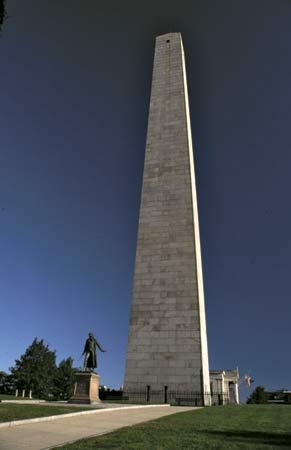Bunker Hill, Battle of
United States history
also known as Battle of Breed's Hill
 (June 17, 1775), first major battle of the American Revolution, fought in Charlestown (now part of Boston) during the Siege of Boston (Boston, Siege of). Although the British eventually won the battle, it was a Pyrrhic victory that lent considerable encouragement to the revolutionary cause. The Bunker Hill Monument, a 221-foot (67-metre) granite obelisk, marks the site on Breed's Hill where most of the fighting took place.
(June 17, 1775), first major battle of the American Revolution, fought in Charlestown (now part of Boston) during the Siege of Boston (Boston, Siege of). Although the British eventually won the battle, it was a Pyrrhic victory that lent considerable encouragement to the revolutionary cause. The Bunker Hill Monument, a 221-foot (67-metre) granite obelisk, marks the site on Breed's Hill where most of the fighting took place. Within two months after the Battles of Lexington and Concord (Lexington and Concord, Battles of) (April 19, 1775), more than 15,000 troops from Massachusetts, Connecticut, New Hampshire, and Rhode Island had assembled in the vicinity of Boston to confront the British army of 5,000 or more stationed there. General Artemas Ward, commander in chief of the Massachusetts troops, served as the senior New England officer. There were two obvious points from which Boston was vulnerable to artillery fire: Dorchester Heights, and two high hills, Bunker's and Breed's, in Charlestown, about a quarter of a mile across the Charles River from the north shore of Boston. By the middle of June, hearing that British general Thomas Gage (Gage, Thomas) was about to occupy Dorchester Heights, the colonists decided to fortify the hills. By the time they were discovered, Colonel William Prescott and his men had completed a redoubt atop Breed's Hill (which was an indefensible decision in the eyes of many historians, since Breed's Hill was lower and less impregnable than Bunker Hill). Despite a cannonade from British men-of-war in the harbour and from a battery across the river in north Boston, the colonists continued to strengthen their position.
Within two months after the Battles of Lexington and Concord (Lexington and Concord, Battles of) (April 19, 1775), more than 15,000 troops from Massachusetts, Connecticut, New Hampshire, and Rhode Island had assembled in the vicinity of Boston to confront the British army of 5,000 or more stationed there. General Artemas Ward, commander in chief of the Massachusetts troops, served as the senior New England officer. There were two obvious points from which Boston was vulnerable to artillery fire: Dorchester Heights, and two high hills, Bunker's and Breed's, in Charlestown, about a quarter of a mile across the Charles River from the north shore of Boston. By the middle of June, hearing that British general Thomas Gage (Gage, Thomas) was about to occupy Dorchester Heights, the colonists decided to fortify the hills. By the time they were discovered, Colonel William Prescott and his men had completed a redoubt atop Breed's Hill (which was an indefensible decision in the eyes of many historians, since Breed's Hill was lower and less impregnable than Bunker Hill). Despite a cannonade from British men-of-war in the harbour and from a battery across the river in north Boston, the colonists continued to strengthen their position.Gage then dispatched about 2,300 troops under Major General William Howe (Howe, William Howe, 5th Viscount) against Prescott. Landing without opposition under artillery protection, the British were stopped by heavy fire from the colonial troops barricaded behind rail fences that had been stuffed with grass, hay, and brush. On the second or third advance, however, the attackers carried the redoubt and forced the surviving defenders, mostly exhausted and weaponless, to flee. Casualties numbered more than 1,000 British and about 450 American soldiers.
If the British had followed this victory with an attack on Dorchester Heights to the south of Boston, it might have been worth the heavy cost. But, presumably because of their severe losses and the fighting spirit displayed by the rebels, the British commanders abandoned or indefinitely postponed such a plan. Consequently, after General George Washington (Washington, George), who took colonial command two weeks later, had collected enough heavy guns and ammunition to threaten Boston, he was able in March 1776 to seize and fortify Dorchester Heights and compel the British to evacuate Boston and the harbour. Also, the heavy losses inflicted on the British in the Battle of Bunker Hill bolstered the Americans' confidence and showed that the relatively inexperienced colonists could indeed fight on par with the mighty redcoats of the British Army.
- Richardson, Sir Owen Willans
- Richardson, Sir Ralph
- Richardson, Tony
- Richard Sorge
- Richards, Sir Gordon
- Richards, Sir Viv
- Richards, Sir William Buell
- Richards, Theodore William
- Richard Strauss
- Richards, William
- Richard Tarlton
- Richard Tauber
- Richard T. Ely
- Richard Teschner
- Richard Thompson
- Richard Thurnwald
- Richard Trevithick
- Richard Tucker
- Richard Upjohn
- Richard von Hertwig
- Richard von Kühlmann
- Richard von Mises
- Richard Wagner
- Richard Whately
- Richard Wilbur